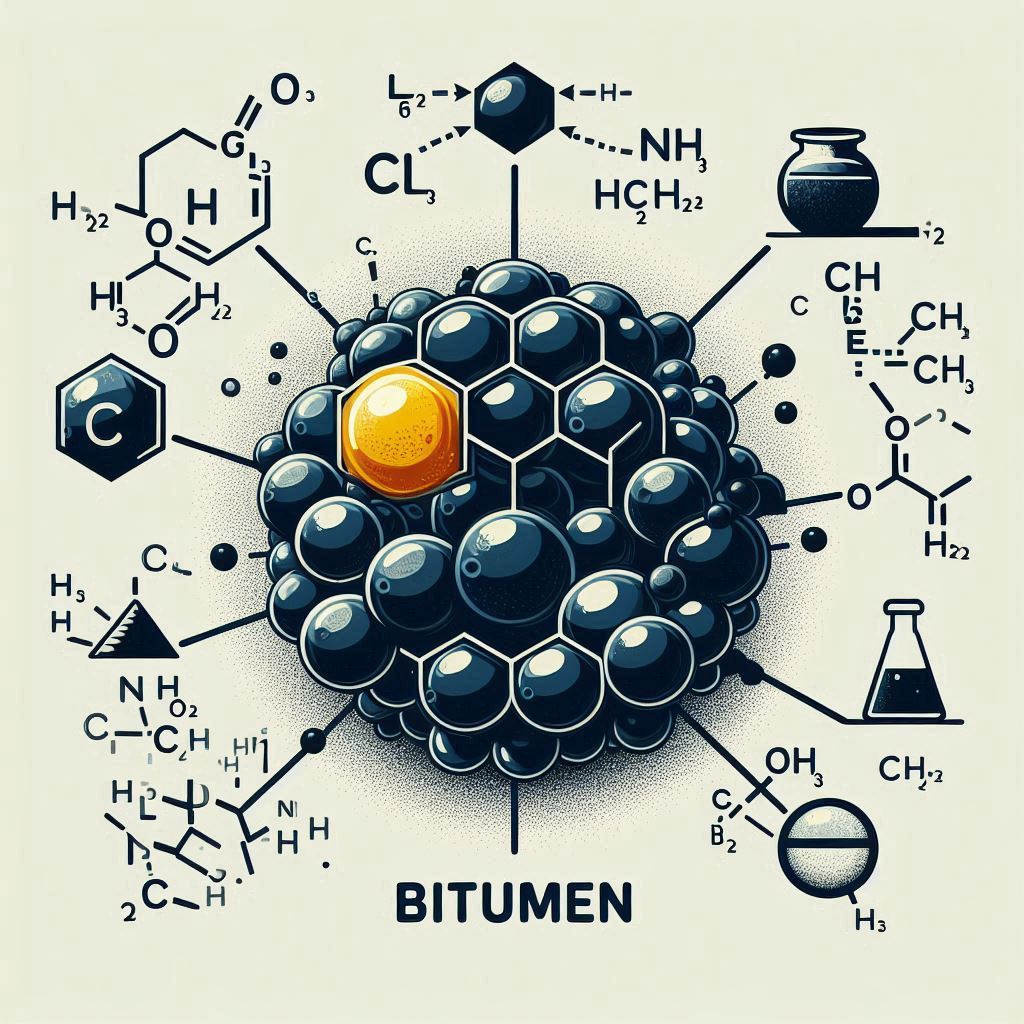
Bitumen Formula, Chemical Name & Composition Explained
Short Intro:
Bitumen is a versatile hydrocarbon material used in roads, roofing, and industrial applications. Understanding its chemical composition helps optimize its performance.
What You’ll Learn:
- Key chemical components of bitumen
- Variability in bitumen’s formula and molecular structure
- Industrial applications and engineering significance
- How composition affects viscosity, adhesion, and durability
- Insights into refining and production processes
- NovinTrades market view on bitumen trends
1) Introduction to Bitumen Formula Chemical Name Symbol Composition
Introduction to Bitumen Formula Chemical Name Symbol Composition
Bitumen, also known as asphalt or tar, is a complex hydrocarbon material whose composition varies depending on geological origin and processing methods. It primarily consists of aliphatic, aromatic, and cyclic molecules held together by carbon-carbon (C-C) and carbon-hydrogen (C-H) bonds. Its molecular formula is often generalized as CnH2n+2, although the precise structure is highly variable.
Bitumen’s unique chemical and physical characteristics—such as viscosity, adhesion, and softening point—make it essential for road construction, waterproofing, and industrial applications. Understanding these properties is critical for producing more durable and efficient materials. This foundational overview sets the stage for exploring its chemical formula, names, symbols, and composition in detail.
Keywords: bitumen chemical formula, asphalt composition, hydrocarbon structure, bitumen properties, molecular structure, industrial bitumen, construction materials
External links:
- Engineering Properties of Bitumen
- Asphalt Institute Resources
2) Bitumen Chemical Formula
Bitumen Chemical Formula
Bitumen chemical formula varies based on its source and processing techniques, making it a complex hydrocarbon material.
Bitumen is primarily produced by distilling crude oil and is a viscous, black, sticky substance. The generalized molecular formula is CnH2n+2, with 'n' representing the number of carbon atoms. Its composition includes aliphatic, aromatic, and cyclic hydrocarbons. Physical properties such as penetration, softening point, and viscosity are determined by these molecular arrangements, which are critical for specific industrial applications.
Keywords: CnH2n+2, hydrocarbon chains, asphalt formula, petroleum distillation, bitumen viscosity, road engineering, industrial applications
External links:
- ScienceDirect: Hydrocarbons in Bitumen
NovinTrades Market View: Bitumen prices remain influenced by crude oil trends and infrastructure demand, with flexible formulations supporting diverse applications.
3) Bitumen Chemical Name
Bitumen Chemical Name
Bitumen does not have a singular chemical name due to its complex and heterogeneous composition. Commonly referred to as asphalt or tar, it is composed mainly of hydrocarbons organized into aliphatic, aromatic, and cyclic structures.
Aromatic hydrocarbons contribute ring structures, enhancing strength and durability, while aliphatic hydrocarbons provide flexibility. Cyclic compounds add viscosity and adhesion. The molecular complexity makes assigning a standard chemical name impractical, but recognizing the hydrocarbon groups is essential for engineering and industrial purposes.
Keywords: asphalt chemical name, tar composition, hydrocarbon types, aliphatic hydrocarbons, aromatic hydrocarbons, cyclic molecules, material science
External links:
- Bitumen Nomenclature Guide
4) Bitumen Chemical Symbol
Bitumen Chemical Symbol
Bitumen lacks a standardized chemical symbol, unlike simple elements, due to its heterogeneous molecular structure. It is primarily a combination of hydrocarbons with carbon and hydrogen atoms forming long chains or rings.
The general molecular formula, CnH2n+2, is used as a representative approximation. Refining methods, fractional distillation, and thermal processing influence its final chemical composition. Despite the absence of a symbol, bitumen’s structural complexity is central to its applications in road engineering, waterproofing, and industrial manufacturing.
Keywords: bitumen symbol, asphalt symbol, hydrocarbon chains, C-C bonds, C-H bonds, industrial bitumen, asphalt applications
External links:
- Asphalt Institute: Chemical Structure
5) Chemical Composition of Bitumen PDF
Chemical Composition of Bitumen PDF
Although a PDF cannot be directly provided, the key chemical composition of bitumen can be summarized for documentation. Bitumen primarily consists of hydrocarbons, classified as:
- Aliphatic Compounds: Straight or branched carbon chains enhancing viscosity and flexibility.
- Aromatic Compounds: Carbon rings contributing strength and durability.
- Cyclic Compounds: Closed-ring structures providing adhesion and viscosity.
The molecular formula is generally expressed as CnH2n+2. Geological conditions, crude oil source, and refining methods create variability, influencing physical properties such as softening point, adhesion, and penetration. Understanding this composition supports better material engineering and industrial applications.
Keywords: bitumen PDF, hydrocarbon composition, aliphatic, aromatic, cyclic compounds, bitumen structure, asphalt properties
External links:
NovinTrades Market Forecast: Bitumen demand continues to rise due to global infrastructure projects. Optimizing chemical composition improves performance for paving, waterproofing, and industrial applications.
6) Conclusion: Bitumen Formula Chemical Name Symbol Composition
Bitumen Formula Chemical Name Symbol Composition
Bitumen’s complex molecular structure, dominated by aliphatic, aromatic, and cyclic hydrocarbons, defines its industrial utility. While it lacks a fixed chemical name or symbol, understanding its chemical composition is crucial for engineering and infrastructure projects.
Knowledge of bitumen’s molecular structure allows researchers and engineers to tailor materials for specific uses, improving durability, flexibility, and performance. The generalized formula CnH2n+2 provides a framework for understanding its hydrocarbons. As demand for road construction, waterproofing, and industrial applications grows, continuous research ensures better material solutions.
Keywords: bitumen formula, asphalt composition, hydrocarbon structure, industrial applications, material engineering, road construction, waterproofing
External links:
- ScienceDirect: Bitumen Research
- Asphalt Institute
Explore more articles and in-depth analyses in the NovinTrades Reportage section.
About NovinTrades
As part of its mission, NovinTrades offers a dedicated Reportage section where businesses, brands, and professionals can publish in-depth sponsored articles, analyses, and thought-leadership pieces. These reportages are SEO-optimized for maximum visibility and long-term engagement.
📍 Explore more at NovinTrades Reportages
📣 Join us on Telegram: https://t.me/novintrades

